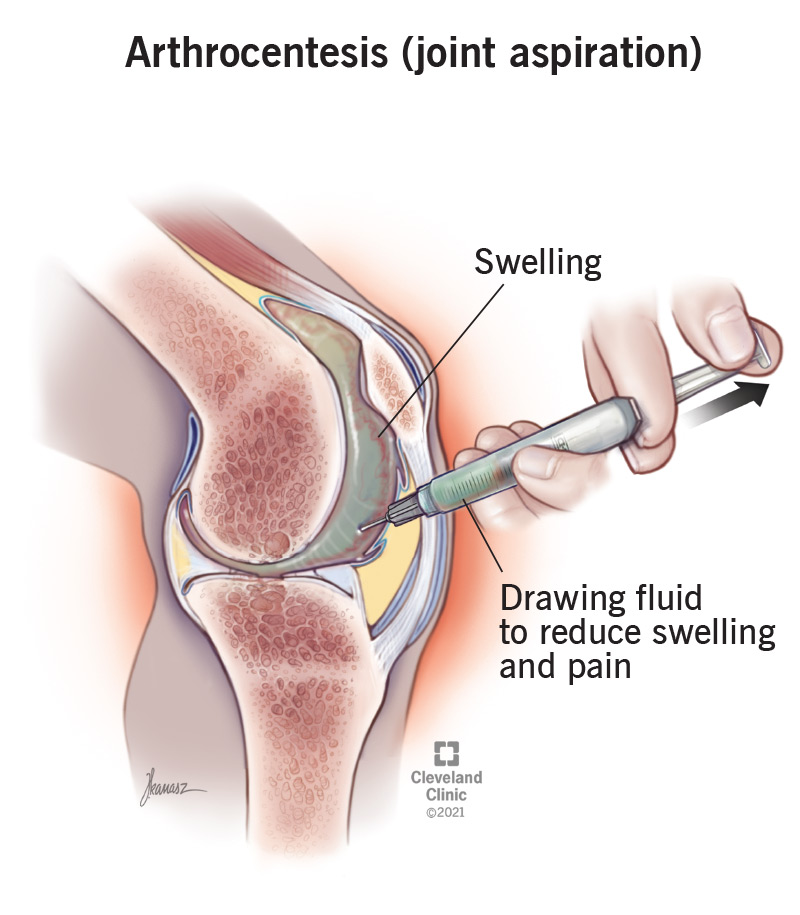You might have arthrocentesis if you have painful swelling in one of your joints, like your knee, hip or ankle. It’s a simple procedure to draw fluid from your joint with a hollow needle and a syringe. Drawing the fluid relieves pressure, and it may also help diagnose your condition.
Advertisement
Cleveland Clinic is a non-profit academic medical center. Advertising on our site helps support our mission. We do not endorse non-Cleveland Clinic products or services. Policy

Arthrocentesis, also called joint aspiration, is a simple procedure to draw fluid from your joint through a hollow needle. If your joint is inflamed and swollen, it will have extra fluid in it. Drawing the fluid out relieves some of the swelling and pain. It can also help your provider learn more about what’s causing it.
Advertisement
Cleveland Clinic is a non-profit academic medical center. Advertising on our site helps support our mission. We do not endorse non-Cleveland Clinic products or services. Policy
Arthro- means joint, and -centesis means to puncture with a needle (to draw fluid). A joint is any place in your body where two bones meet, like your knee, your hip, your elbow or your knuckle. “Aspiration” is just another term for a medical procedure to withdraw fluid (or sometimes gas) from your body.
You can have arthrocentesis in your healthcare provider’s office, or as an outpatient procedure at the hospital. You don’t need to prepare ahead of time. When you arrive, your healthcare provider will:
The whole procedure takes about 10 minutes. It might take a few more if your provider uses imaging, if you need to wait for anesthesia to work or if you’re having a joint injection with your joint aspiration.
Advertisement
Complications of arthrocentesis are rare. They include:
Arthrocentesis has several purposes, and it often serves more than one at a time. It’s both therapeutic and diagnostic. It can help relieve your symptoms and set the stage for further treatment. It can also help your healthcare provider learn more about your condition when they send the sample to a lab for analysis.
Benefits include:
Pain relief. Inflammation in your joint can cause it to swell with excess fluid. This can be a major source of your joint pain. Drawing some of the fluid out reduces the swelling to relieve some of the pain.
Preparation. Arthrocentesis (joint aspiration) can also help prepare your joint for a therapeutic injection. Drawing excess fluid out makes room for injected medications that treat arthritis, like:
Diagnosis. Once your healthcare provider has drawn a sample of your joint fluid (synovial fluid), the sample might prove useful. They can send it to a lab to analyze (synovial fluid analysis) and check for:
Joint aspirations and injections are relatively safe. Rarely, these complications develop:
Your provider will bandage your joint and may advise you to rest it for a while. How long depends on your individual condition. If they sent your sample to a lab, they’ll let you know when they have the results.
If you had joint aspiration to relieve pain and swelling, you should begin to feel relief over the next day or so. Depending on what caused the swelling and how severe it was, the relief might be temporary. Sometimes, swelling returns a few days later, and you may need another aspiration to relieve it.
If you have a chronic condition, like arthritis, your symptoms might return more gradually. Your healthcare provider can advise you on when you can have another joint aspiration and/or injection. Different types of joint injections have different rules about how often you should have them.
Advertisement
Contact your healthcare provider if you experience any unusual symptoms after your procedure, like:
Arthrocentesis is a simple procedure with many benefits. It can treat joint swelling and pain and sometimes help your provider diagnose the cause. The experience is similar to having your blood drawn. You’ll have to endure a needle prick or two. But the relief you’ll gain from it will last much longer.
Advertisement
From sudden injuries to chronic conditions, Cleveland Clinic’s orthopaedic providers can guide you through testing, treatment and beyond.

Last reviewed on 12/22/2024.
Learn more about the Health Library and our editorial process.